On Wednesday, 8 August, 2018, I was made an honorary member of the “PIB, NGIB, HQ, PIR Association on the occasion of the Kokoda Day Memorial Service to commemorate the 76th anniversary of the Defence of Kokoda (8-10 August, 1942) by the 39th Australian Infantry Battalion, and the Papuan Infantry Battalion. This auspices day also celebrated the 10th anniversary of the Rotary Kokoda Memorial Wall at the Cascade Gardens, Broadbeach, Gold coast, Australia.
Lahui Ako
Lahui Ako is an author and a blogger. He fully supports the promotion of healthy living, while preserving the legacy of all the Nameless Warriors of the PIB and the PIR who have fought to defend our freedom, LEST WE FORGET!
An “Honorary” member of the PIB, NGIP, HQ, PIR Association
SATURDAY, AUGUST 11, 2018

Sometimes in June, I received an email from my good friend, George Friend who resides in the Gold Coast, asking for my availability on the day. Without any hesitation, I said, “Yes, I would be honoured to be part of this celebration.” My answer was also fueled by the fact that PIR legend, Lt Col (retired) Maurie Pears, had specifically asked for me to be part of this commemoration; I wasn’t going to say otherwise to that. Maurie (as he insisted to be called) had played a crucial and important role in the history of the PIB, the NGIB, and the PIR through the two “TO FIND A PATH” books.
So, I left for the Gold Coast that sunny Tuesday afternoon (Tuesday, 7 August 2018) to participate in this service. I arrived around 5pm and was waiting in the passenger pickup areas for George when a young handsome chap, from PNG, slowly walked up to me, and with a shy but confident manner, asked, “Good afternoon sir, are you Mr Ako?” I answered in the affirmative.
“Oh good. Name blo mi em Solomon. George sent me. Em waitim yu lo hapsait,” and he beckon to me to follow him.
So, I was introduced to Solomon Kasokason. A tall handsome bloke, who, from my first impression, has a very bright future ahead of him. His mixture of English and Pidgin, in one sentence, only portrayed his respect for me as an elder; and while acknowledging his knowledge of English, he was also reminding me that he too, respected his roots, as a Papua New Guinean.
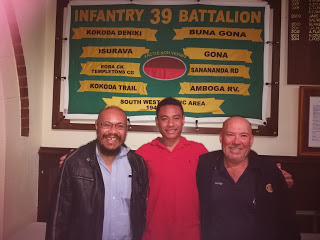
We got on with George and we were off to the Gold Coast. Along the way George and I discussed a myriad of issues, mainly centred on our favourite topic: the PIB/39th Battalion and the war at Kokoda. When he asked me about the last Remembrance Day celebrations, I told him that “it would seem to me nowadays that most are only paying lip service to this occasion.”
“How come?” he asked.
“Well, what is there to commemorate this occasion?” I said. “You have a dawn service on the day, which is then followed by a parade and speeches by dignitaries; and topped off with a luncheon; and that’s it. Everyone goes back home to their lives, with the events of the past ten hours gone and forgotten. There must still be something that can add more value, substance and quality to this occasion so that it is commemorated as it should be.” I paused. “Ironically, most of our uni graduates don’t even know what the acronym PIB stands for. And I don’t blame them; how can they know something they haven’t being taught,” I lamented.
George didn’t say anything as we finally drove into the Southport School, where young Solomon goes to.
According to George, the Southport School is an independent, Anglican, day and boarding school for boys, located in Southport, a suburb on the Gold Coast of Queensland, Australia. Established in 1901 by The Right Reverend Horace Henry Dixon, TSS is the oldest Anglican boys’ boarding school in Queensland and the only all-boys boarding school on the Gold Coast. The school has a non-selective enrolment policy and currently caters for approximately 1305 students from pre-school to Year 12, including 276 boarders from Years 7 to 12.
George and Solomon brought me to their Chapel where the honor roll is kept and I met Fr Jonathon Whereat, the Chaplain of the school. We both then bid Solomon good night and left.
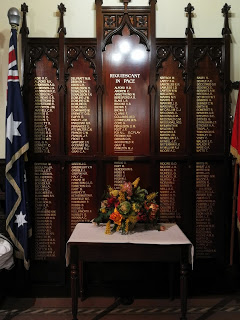
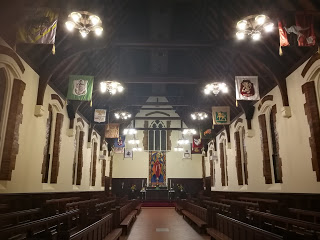
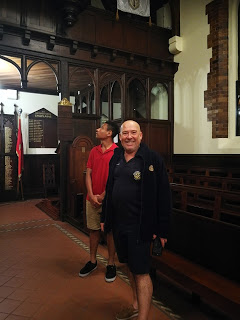
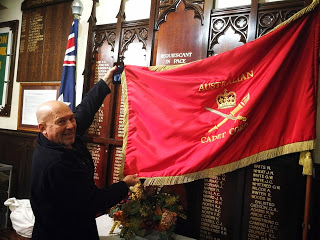

George, through the Rotary club, had organized for me to stay at the Gold Coast Hilton. I checked-in, and then we, (me, George and Evelyn, his lovely wife) went off to the Chinese restaurant across the road to have some dinner. During dinner, George went through the next day’s program with me and prepped me up for it.
I woke up around 0530 and went off for my usual 5k run and calisthenics. By 0830 I was at the restaurant where I enjoyed a hearty breakfast. I went back to the room to change and to prep myself for the day, check my speech, etc. George had reminded me last night that the program would start at 1030 so I was to try to make it to the venue by 1000. “Well I wasn’t going to be late,” I said to myself. I left the hotel at 0940 for the tram line just as the tram was coming in. I let that one go and decided to wait for the next one which would be coming through at around 0955. George had told me that the trip to the stop near the Cascade Gardens was about 10 minutes. So, the next tram arrived and I got on.


As I made myself comfortable on the seat, I couldn’t help but notice three old soldiers – yes, old soldiers – because they had medals on their chest. I immediately deduced that they were on their way to the Service, so I was in good hands. As a foreigner, you always have these feelings, especially in places you are not familiar with; about getting lost! I had that for a few seconds when I was getting into the tram: “Am I getting on the correct tram? Or the wrong one, which will take me to the wrong stations? etc, etc, etc.” So, seeing these old soldiers with their fruit salads assured me that I was in the correct tram going the correct way.
We all got off at Florida Gardens, and the three warriors immediately set off for the Cascade Gardens. I quickly walked up to them and asked if I could join them on their walk to the Gardens. Without any reservations, they said, “By all means, join us; and are you also here for the Kokoda service?” I answered in the affirmative.
As I tagged along with them, I didn’t realize it at that moment but something was about to happen; something that would be wonderful and life enriching. Of these three friends, one was a bit more older than the other two. (They told me later at the luncheon that they were navy who saw service at the Vietnam War; while their older mate had been to the Korean War; but that they had also done service up in Lombrum and Port Moresby from the 1960s onwards). As we walked, the two younger friends were already setting a quick pace and so we about five paces in front; I decided to walk with their older mate behind. But one thing that struck me was that every now and then, the two younger friends would back track to their older mate, and with respect and love in their voices, gently encourage him, telling him that it wasn’t that far to go, and that only a few more steps and we would be there; that this distance was nothing compared to the training they all did at recruit training camp, and so on, etc. Their old friend would nod his understanding and in the typical Aussie fashion, tell them to lead on. I think the friends backtracked a total of six times in that 20 minutes until we arrived at the Cascade gardens. It was only a 5-minutes walk from the stop.
By the time we arrived at the Cascade Gardens, the place was already swarming with veterans who had seen service in PNG. I excused myself from the three friends and went off to look for George. Before I could walk any further, I saw an old man alight from a vehicle. He had a walking stick. “That must be Maurie Pears,” I thought. During last night’s dinner, Evelyn had told me that Maurie (as he liked to be called) used a walking stick.
I walked up slowly to him, and tapped him on the shoulders and said, “Good morning, Sir. Are you Mr Maurie Pears?” I asked. “I am Lah…”
Before I could complete my introductions, Maurie gave a loud shout, and yelled out my name, “LAHUI AKO!”
I was caught with surprise and bewilderment.
“Boys, come on over here. This is the gentleman we have been talking about these past weeks. Lahui Ako. He came, boys. He made it!”
I got introduced to about ten or so veterans in the next 10 minutes, as Maurie proceeded on to introduce me to this person, and that person, and that persons and that person…; and they all had the same sentiment, “Thank you for accepting our invitation and coming to graze us with your presence.”
I could only nod in bewilderment and confusion. “Why are they treating me like a VIP? I am 30-40 years younger than all of them; it should be me doing that to them,” I thought to myself with confusion written all over my face.
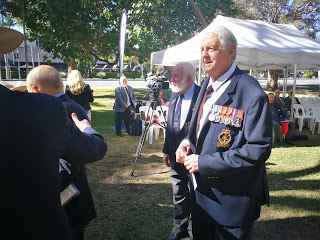
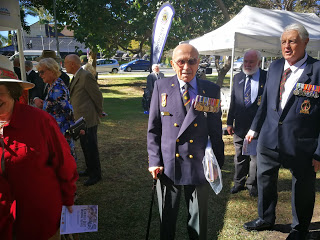
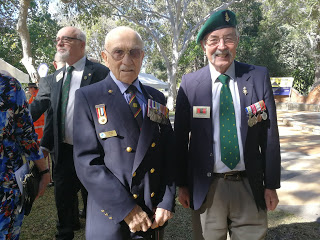
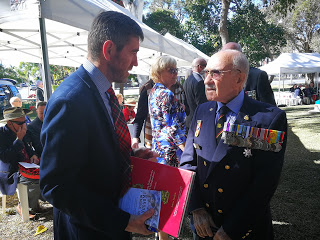
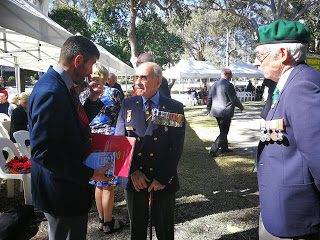
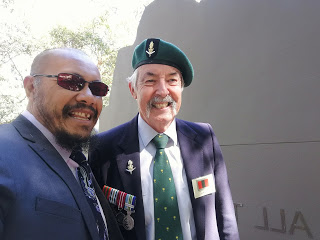
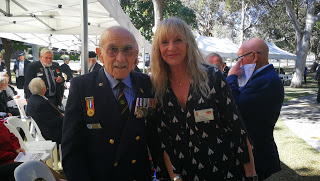
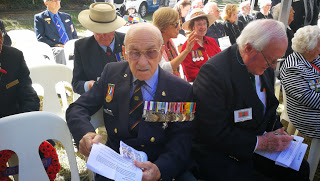
George Friend, OAM, of the Rotary Broadwater Southport, was the Master-of-Ceremony; and around 10:15 he called the gathering to order, and commenced the program.
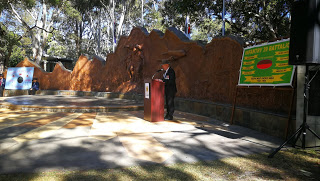
The ceremony was opened with a prayer by Fr Whereat (yes, the TSS Chaplain I met last night), followed by the hymn, Abide with Me. George then invited Maurie Pears, MC to give the Governor-General’s Message to the gathering.
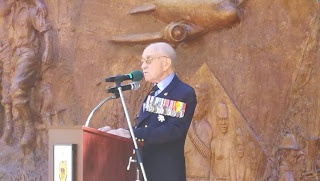
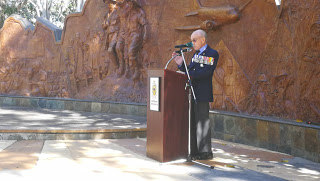

After Maurie had delivered the Governor-General’s message, George then invited me to give the Keynote Address to the gathering. Below is the Keynote speech I gave to this esteemed gathering:
Excellencies,
Ladies and Gentlemen;
Boys and girls;
Many Papuans and New Guineans fought the enemy when the war came to Papua in 1942 – either with the Allied forces or with the Japanese – as carriers, labourers, and informers. Of these, some 3,000 of them fought as regular soldiers under the banner of the Papuan and New Guinea Infantry Battalions. All fought for their own reasons: some were teenagers who joined to attain status, or because they were coerced into joining. Others made the transition from the constabulary into the army.
After the setback of the Coral Sea Battle, the enemy decided to try a two-prong assault on Port Moresby with their land forces. On 21 July 1942, they landed near Gona with more than a thousand, mostly Tolai, carriers. Lightly equipped, the 3,000 troops quickly set off inland for Kokoda, where there was a small but vital airstrip – their springboard for the final attack on Port Moresby.
They were virtually unopposed until they ran into a PIB ambush at a place called Awala. They brushed this puny defence aside and advanced. Kokoda was in their hands barely a week after the landings.
What a lot of people today do not realize is that this historic PIB ambush at Awala was the beginning of a bond – a bond of camaraderie, love and friendship, commitment and understanding, courage and perseverance, and of loyalty and the ultimate sacrifice, between warriors of mostly different races, but fighting a common enemy – a bond that would span throughout the duration of the war, right up to the disbanding of the PIB in 1946; a bond that would be reignited with the reformation of the PIR in 1951 and continue right past 1976 when the newly independent state of Papua New Guinea assumed full ownership of its armed forces right up to this very day.
For the Papuan, it mattered little where the war intruded from; only that his immediate territory had been invaded; and therefore, it was his tribal duty and responsibility to fight off the invaders of his land. The Kokoda campaign therefore, became, for the most part, a fight to keep the invaders away from their own villages and livelihood.
Today, as we solemnly gather here to commemorate the Battle of Kokoda, and the 10th anniversary of the Rotary Kokoda Memorial Wall, I would like to pay homage and tribute to all those Papuan and indigenous soldiers who fought for the safety and livelihood of their homes and villages.
Unbeknown to them, they were part of the world’s greatest struggle against tyranny and oppression by an enemy fully committed to world domination; and they triumphed.
In the same vein, I would also like to pay my respects to those young Australian warriors, who saw fit to lay down their lives in the defense of their homes. It is for these men, and those who walked out of this Battle alive, that we must work hard to forever keep their memories, lest we forget.
These warriors, despite the difference of their lifestyles and upbringings, stood together as one, to fight off the invader.
This bond, between the Australian and the Papua New Guinean warrior, forged in blood, in the jungles of Kokoda, has remained right up to this very day, as one of the commonwealth’s strongest bilateral relations between any two of its members.
So, as I stand here, humbly, in your esteemed presence, my Australian friends, many of whom I gladly call my brothers, have been up in Port Moresby these past 12 or so months, helping us play host to the year-long Asia-Pacific Economic Cooperation (APEC) series of meetings, that will culminate with the Leaders’ Summit this November. This is this very bond I am talking about.
I will conclude by saying that the Battle of Kokoda, and the ensuing battles after that, was the biggest ever capacity building exercise provided to thousands of Papua New Guineans by Australia then. The knowledge they acquired during that war, be it on leadership, navigation, as medics, cooks, store-men, logistics, and teachers of men – all these was put to good use when they returned home to their villages after the war. Some entered politics, others continued to serve their local communities in their own respective capacities. Most used these training to better the livelihood of their communities.
Seventy-six years on, this legacy has continued. Today, another massive capacity building exercise is again in motion in Port Moresby, as PNG prepares to complete its hosting year with the APEC Leaders’ Summit in November. Again, our brothers from Australia are assisting us with its preparations.
We Papua New Guineans of this generation, are optimistic that the capacity building and training offered by Australia to hundreds of our officials, will again be put to good use beyond APEC, to better our lives, and in that process, advance our ever burgeoning relations to the next levels.
I pray that God continues to nurture this friendship forever, lest we forget.
Thank you.
After the Keynote address, George called for the Catafalque Party to mount. This Guard party was formed by the school cadets from the TSS. They stood to, while the laying of the wreaths commenced. I was also called upon to lay a wreath on behalf of the Government of Papua New Guinea.
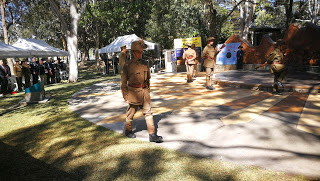
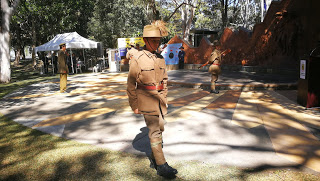
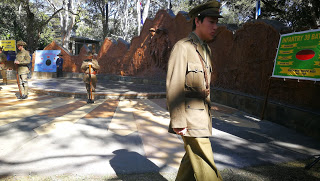
This was then followed immediately by the announcing of the honour roll of the 39th Battalion and the PIB. This was done by TSS cadets and Papua New Guineans, Anthony Apana, and Solomon Kasokason. This brought some emotions with it. Because while could view this as a formality, the fact that it was being read to the gathering by the two true-born Papua New Guineans was significant. This portrayed the message to the world that we Papua New Guineans, too, honour those warriors who fought for our freedom to win back Kokoda from the invading Japanese forces.
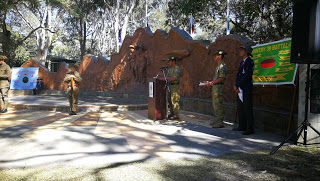
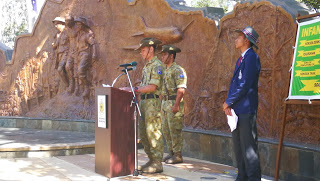
After the laying of the wreaths, the Ode was read by Mr. Craig Thomas, Director of the Southport RSL. This was immediately followed by the “Last Post”, then by the “Rouse”. Father Whereat then gave the benediction. After the benediction, the National Anthems of PNG and Australia were sung. The dismounting of the Catafalque Party formally ended the Service.
After greeting and meeting numerous members of the gathering, I was led away by Mr. Donald Graham, the President of the PIB, NGIB, HQ, PIR Association, to the behind of the Rotary Kokoda Memorial Wall – to another ceremony. This ceremony was officiated by Mr. Graham himself and it was to show me the pavement behind the Wall which now had the names of all the highly decorated PIB and NGIB heroes. At the end of his speech, I was literally bowled over, when they presented to me my certificated inducting me into the “PIB, NGIB, HQ, PIR Association” as an Honorary Member. I was dumbfound, bewildered, and completely caught off guard for this honour. As I said my words of appreciations, thanking these esteemed gentlemen and their wives, for this great honour, I was thinking to myself: “I am truly undeserving of this honour. For goodness, I feel like an interloper, stepping onto grounds which I have no right to step on . . .”
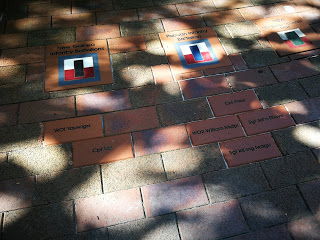
We then all went off to the RSL Club for luncheon. I immediately went off in search of the three old warriors who had led me to the Cascade Gardens. When they saw me approach them, one of them called out, “And you told us that you were here to witness the occasion. you never said anything about a Keynote address!”
I looked sheepishly at them and said, “But you never asked me what I was here for, eh?”
They all laughed and told me to join them.
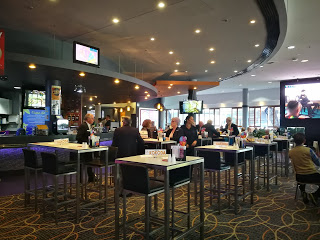
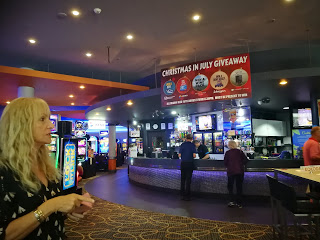
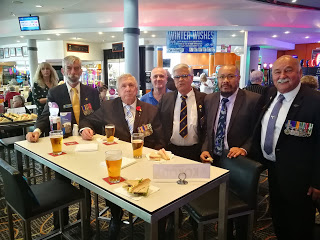
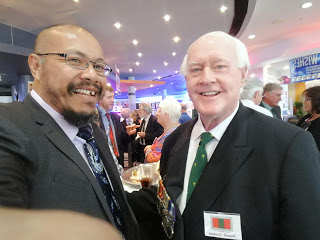
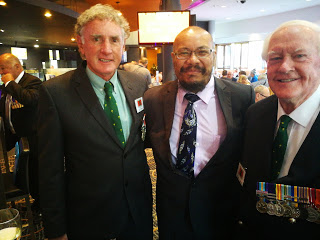
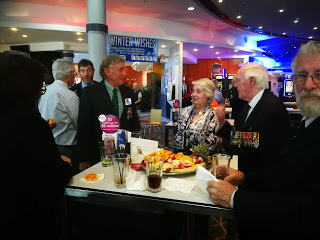
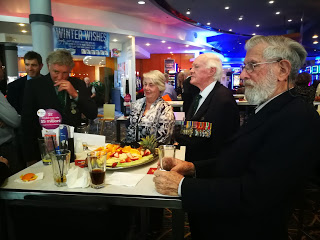
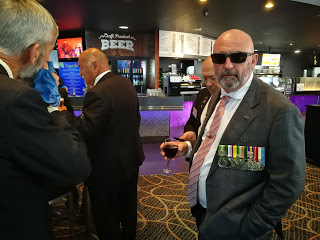
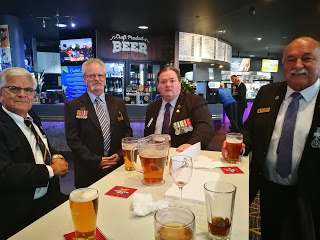
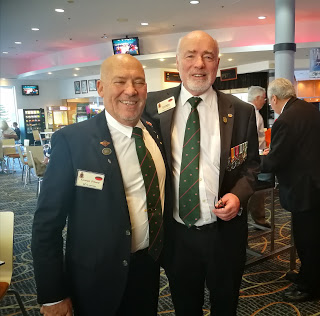
John Gorski, who was a Stoker on one of the naval ship, and who called in now and then in the 1960s into Lombrum also gave me his Stoker’s badge, saying, “Lahui, I am giving you this, firstly to show you that the Navy remains the best military fighting force in the world (to much laughter from the gathering); but most importantly, I want you to remember our walk after we got off the tram until we arrived at the Cascade gardens.”
“That was one of the most important walks I ever made in my life,” I told them.
“How come?” They chorused.
“Well, because in that 20 minutes walk, I learnt about – caring, love for your mates, commitment, and encouraging one another as we work towards our objectives in life. All in all, this was TEAM WORK in its true practical sense,” I told them; and as I talked, their laughter subsided and they became very quiet and thoughtful as they pondered on my assessment.
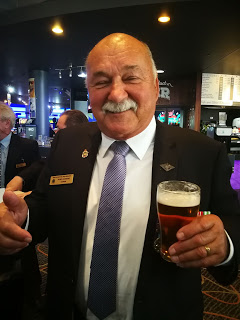

Then I went over to join Mr. Graham and the other members of the party at their table for a coffee. Maj (retired) Don Graham (President), and Sgt (retired) Ken Norton (Secretary) of the PIB, NGIB, HQ, PIR Association had served during different times at Taurama Barracks. Don served in the 1950s while Ken served in the 1960s.
While Papua remained an Australian territory after the war the legal position regarding New Guinea was different. On 13 December, 1946, the UN granted Australia a Trusteeship over what was now the Trust Territory of New Guinea. Article IV of the Trusteeship Agreement made Australia the Administrative Authority responsible for “Peace, Order, Good Governance, and Defence” of the Territory, while Article VII of the Trusteeship authorized it to take “all measures” desirable “to provide for the Defence of the Territory, and for the maintenance of internal Peace and Security.”[1]
With this, Australia now had the legal and moral duty to defend PNG, whose security had always been seen to be bound up with that of Australia’s. In fact, defence and security considerations were the principle reasons why Australia urged a reluctant Great Britain, in the first place, into annexing British New Guinea in 1884. Commodore Erskine’s ceremony atop Hanuabada’s Metoreia Hill is evidence of this undertaking. However, in the early post-WW2 years, there appeared to be no real need to reestablish an army presence in PNG. Rightly so too, as was argued by its administrators. The only security risk was further up north in Korea, they concluded.
But one senior army officer by the name of Major-General V.C Secombe, CBE, thought otherwise. General Secombe happened to be the General Officer Commanding (GOC) Northern Command and he took great personal interest in this issue, and made others become aware of this issue.
So, considerations began to surface on this very issue, and the main question became: what form would this take? Answers were demanded on the military effectiveness, discipline and reliability of “native” troops, if such an idea was to be implemented. Would training Papua New Guineans in the use of arm pose problems for the post-war administrations, some asked? Critics made reference to “racial issues” immediately after the war to defend their reasoning.
In July 1949, Colonel J.K Murray, Administrator of the Territory, called for the immediate establishment of a “whites only” unit along the lines of the wartime NGVR, to be known as the PNG Volunteer Rifles (PNGVR). On 23 July, Percy Spender, the Minister for External Territories, announced Cabinet’s approval for the PNGVR to be raised. According to Sinclair (To Find a Path: Volume 2), a letter in the Sydney Morning Herald on 1 February 1950, suggested that “it would be regrettable if PNGVR was raised unless a native militia was raised as well”. This was already under consideration. On 1 June 1950, Spender confirmed that approval had been granted by Cabinet, for the establishment of a PNG division of the Royal Australian Navy. The establishment of a “native regiment” was also under consideration. So, on 23 November 1950, the ARA HQ issued the Raising Instruction.
This move was received with mixed feelings in PNG. Most of the key officers in ANGAU had been ex-officers of the pre-war Administrations. A number of them had returned to become the first post-war District Officers and Assistant District Officers. Some retained their old prejudices. Many people in commerce and on plantations doubted the wisdom of “raising Native units” in peacetime. But there was also strong support from a number of members of one influential section of the white population – the Returned Services League (RSL).
Still, the decision to raise the PIR had been made; but it would be some time before it was implemented. The PIR was placed under the command of Maj-Gen Secombe. Land was secured and Taurama Barracks came into being, with the civilian Administration acting as the Recruiting Agency pending the arrival of the ARA Advance team to commence the recruitment process. On 16 February 1951, the ARA Advance Party arrived from Brisbane. It was headed by Major W.R.J. Shields as acting CO PIR, and included Captain R. Orme, and WO2s Jack Ord, Pat Williams and Ken Wood. The team had been very carefully chosen – Shields and Ord had previously served with the NGIB, while Orme had been with the PIB during WW2.[2] They were old hands in the game, so to speak.
Word on this recruitment exercise had gone out to the hinterlands and coasts. How it reached far and wide, without telephones and effective radio communications, remains a mystery. Still, this news was received by the veterans with much joy and happiness. Nearly all the WW2 veterans, who couldn’t fit back into their own traditional societies. flocked back to take up arms again. Recruitment began on the day the Party arrived and Capt. Orme enlisted ten men that day. The honor of being the first PNG recruit fell on the proud shoulders of Boino Warko from the northern district. Warko had served in the Constabulary during WW2. Over the next couple of days, a total of 81 men would be enlisted in this first draft; Included in this first draft, would be a slimly built man from Loupom Island in the Abau district, named George Ilau Bae whose Service Number would be 802.
On 11 March 1951, the PIR became a unit in the Australian Army.
It was because of the above, that men like Maj (rtd) Graham, Sgt. (rtd) Norton, and Sgt. (rtd) Greg Ivey would see service at Taurama and Igam Barracks – providing capacity building to the infant military organization. These men, and countless others, would serve in their respective capacities from 1951 up to 1976 when all military powers would be handed over to the newly independent State of Papua New Guinea.
Sitting down and listening to them, I realized their drive in maintaining the history of something they built and love so well right up to this day – the PIR.
Later, after I was generously given a lift to Brisbane by Greg Ivey, and as we were saying our farewells and me thanking him for everything, this was what he said, “No. Thank you, Lahui. Today was the start of a new chapter in the life of this association. For years, the PIB and the NGIB’s role in WW2 has always been told by Australians.
Your Nameless Warriors book, is the first ever book on WW2 in PNG, written by a Papua New Guinean. You captured the spirit of the PIB and the NGIB in it. This spirit can never be replicated by any Australian ever. But by a true-born Papuan, like yourself, yes.”
I could only nod at him as he got in his car and took off to his home on the Sunshine coast. There were huge lumps in my throat.

On the road with Greg to Brisbane
Wednesday, 8 August, 2018 will forever remain a very significant date in my life:
1. The awarding of an Honorary Membership into the PIB, NGIB, HQ, PIR Association.
– My next project, with a tentative publishing date of first quarter, 2019, will pay homage to this honour. The book will portray one of the famous military families in PNG, and their travels from the reactivation of the PIR in 1951 right up to the pinnacle of the PNGDF hierarchy in 2010.
2. The TSS and the role they play as cadets.
– Shouldnt it be high time the powers that may be start considering the reactivation of the cadet scheme in PNG? Such a scheme will provide the necessary support needed by the organizers of the annual Remembrance Day Celebrations and ensure that these occasions become meaningful and can be maintained annually for generations to come. I remain of the view that our Remembrance Day celebrations lack substance and we utter the words “Lest we forget” without meaning it.
3. I will continue to write, write, write, and write about our wartime heritage so that all our generations, including those who are yet to be born, will know how our freedom was won!
LEST WE FORGET
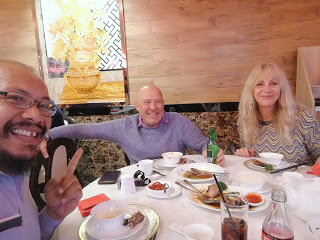
Dinner with George and Evelyn.
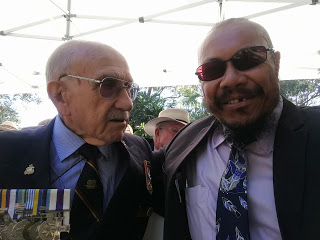
With the PIR legend, Lt Col (rtd) Maurie Pears, MC